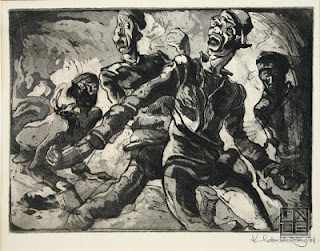Koloman Sokol was born December 12, 1902
in Liptovsky Mikulas and he died
January 12, 2003 in Tucson, Arizona . Largely
considered one of the most prominent of Slovakia’s contemporary artists, Sokol
was a founder of modern printmaking
and graphic arts in Slovakia.
 Sokol attended private schools with Eugen Krón and Gustáv Mallý, and he attended the Academy of Fine Arts in Prague, where he studied under Max Svabinsky. He was also a member of the SČUG Hollar, a Czechoslovak graphic artist association. After studying briefly with František Kupka in Paris, the Mexican Ministry of Culture and Education invited him to teach graphic techniques, so he taught at the Escuela de las Artes del Libro and at the University of Mexico City.
Sokol attended private schools with Eugen Krón and Gustáv Mallý, and he attended the Academy of Fine Arts in Prague, where he studied under Max Svabinsky. He was also a member of the SČUG Hollar, a Czechoslovak graphic artist association. After studying briefly with František Kupka in Paris, the Mexican Ministry of Culture and Education invited him to teach graphic techniques, so he taught at the Escuela de las Artes del Libro and at the University of Mexico City.
In 1946 Sokol returned to Slovakia to teach at the Slovak University of Technology and at the Comenius University until 1948 when the Communists took control of the country. From that point on he lived in the United States and settled in a Philadelphia suburb, up to the last decade of his long life when he moved to Tucson, Arizona. He died there at the age of 100.
Sokol's work was inspired by Expressionist notables Vincent van Gogh, Käthe Kolwitz, and George Grosz. He also felt a strong affinity with the Die Brücke Group. As a technically classic printmaker, Sokol’s prints stayed pretty much within the boundaries of the medium, venturing more toward mixed media with his paintings and drawings. His art expresses ethnic and social issues affecting Man’s suffering and pain, while his dynamic style also calls to mind some of the expressively powerful characters found in his Mexican contemporaries’ (Orozco and Siquieros) work.
Koloman Sokol’s life was full of social and political upheavals, immigration, and a search for creative expression. His artwork speaks about universal truths: the struggle for political, economic and cultural freedoms, all the while informed by social criticism and a visionary symbolical-mythological imagination. His work is seen as unique amongst his peers and a blend of Eastern European Expressionism/Modernism, and yet, for all of his career, Sokol was never enamored of fame. He was an artist of modest means, who remained true to his artistic vision.
As testamony to the impact of Sokol's art to the people of Slovakia, The Pongrac Manor Home, a former feudal manor built in 1450, has been dedicated to Koloman Sokol. In addition to a small permanent collection of Sokol's work, the Center shows 6-8 exhibitions of Slovakian and international artists per year. For more information on the Center, please their address below.
The Koloman Sokol Center
Námestie osloboditeľov 28
+421/44/562 00 35 • www.muzeum.sk
Opening hours:
all-year-round: Tu-Sa: 10.00-17.00



Thank you for including my grandfather (Dedo) in your blog. Certainly he is smiling now, appreciative that there continues to be an interest in his life's passion, which was truly derived from his blood, sweat and tears.
ReplyDeleteKind regards,
Nik Sokol
niksokol@gmail.com
If you wish to spend a passionate meeting with an adult companion in Slovakia, you are at the right place. EscortFox.com is the leading and most trusted escort directory worldwide. We are currently listing call girls, erotic massages or other escort services in the following cities. To know more information visit Escort girls in Slovakia
ReplyDelete